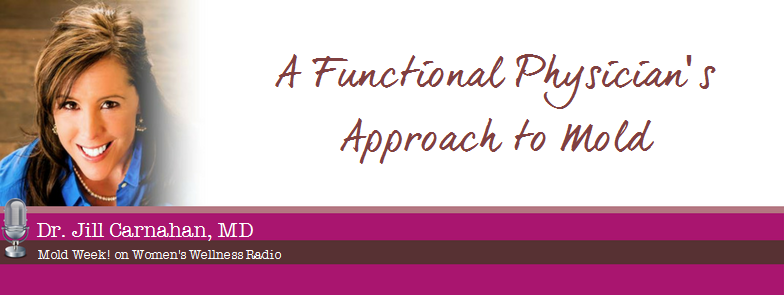When I got sick with toxic mold from a water-damaged building, I later learned about mycotoxins (mold toxins) in food. At first I thought, “That seems overblown,” but as I learned more I realized that many of the ‘moldy foods’ were the same ones I didn’t tolerate!
While mold in foods alone can cause severe, acute toxicity, I think it’s more often a contributing factor to an already burdened and dysregulated body. (1)
Read on to learn which foods can be moldy, the possible health risk, how to limit exposure and how to recover from illness due to toxicity.
Toxic Mold in Foods
Mold can grow on foods in the presence of heat and moisture while foods are still growing in the field, being transported, being processed, or being stored, including as leftovers. (2)
Not all mold is toxic, but all not all mold is even visible in your food supply. That’s why it’s important to know which foods can potentially be moldy. (3)
Currently there about 400 identified mycotoxins with about a dozen of those harmful to human health. (4)
The health risk of mold in food is on the radar of the World Health Organization, and there is even a task force to regulate levels of mold in food.
“Risk assessments of mycotoxins in food done by the Joint FAO/WHO Expert Committee on Food Additives (JECFA) are used by governments and by the Codex Alimentarius Commission (the intergovernmental standards-setting body for food) to establish maximum levels in food or provide other risk management advice to control or prevent contamination.
The maximum levels for mycotoxins in food are very low due to their severe toxicity. For example, the maximum levels for aflatoxins set by the Codex in various nuts, grains, dried figs and milk are in the range of 0.5 to 15 µg/kg (a µg is one billionth of a kilogram). The Codex maximum limit for patulin in apple juice is 50 µg/L.
Exposure to mycotoxins needs to be kept as low as possible to protect the people. Mycotoxins not only pose a risk to both human and animal health, but also impact food security and nutrition by reducing people’s access to healthy food.” (5)
The USDA provides mycotoxin testing of grains but it appears the only mandatory testing for mycotoxins is corn we export, according to a 2015 USDA handbook. (6)
Certification of mycotoxin status does not need to be at zero but instead below a designated level of safety per type of mycotoxin (these levels are generally quite low in a small number of parts per million or billion). (7)
From my initial research, it does not appear that all foods are tested for mycotoxins, but that in private industry a purchaser may ask for a lot of crop to be tested.
Some of these samples were used by the FDA in the case of testing apple juice for levels of the mycotoxin patulin. It was then investigated how much apple juice was consumed by different age groups, and then advisable levels of patulin that could be present in apple juice. (8)
In short, there is some regulation of acceptable levels of toxic mold in food, but I’m not sure that regulation is rigorous, and it may not suffice for people with a pre-existing mold sensitivity.
The Possible Health Effects of Mold in Food
As I mentioned in the introduction, I think it’s rare that the only cause of a symptom would be moldy food.
Health devolves, usually, thanks to combination of stress, nutrient depletion, toxic exposure, dysregulation of hormones and breakdown of organ function. (9)
“Mycotoxins cause different degrees of toxicity according to exposure time, mycotoxin amount, physiological state, and sensitivity of the organism in humans and animals.” (10)
So please don’t see these lists of possible symptoms and foods and think, “Oh, no! I can’t eat any of this or I’ll get sick! What can I even eat anymore??!”
We will cover how/when/if to avoid possibly moldy foods later in this article.
Here are some possible symptoms that you may experience if you eat moldy foods that you are sensitive to:
Headaches, especially after eating
Drugged or high feeling
Weakened immunity
Chronic respiratory issues
Sneezing
Anger
Brain fog
Anxiety (11)
Brain abnormalities
Depression
Insomnia
Acute abdominal pain (12)
IBS (Irritable Bowel Syndrome)
Rashes
Vertigo (13)
ADHD (14)
Mycotoxins, depending on the species, can be carcinogenic, mutagenic, nephrotoxic, or hepatotoxic and can contribute to serious, long-term diseases, especially with chronic exposure. (15)
15 Foods that Grow Mold Easily
Any grain: whole or in a product like bread or chips
Grain-fed meat
Dog food (16)
Spices, especially red chilli, black pepper, and dry ginger (17)
Herbal supplements, especially milk thistle (18)
Dairy products
Cocoa
Oat, soy or rice milk (19)
Fruit juice and dried fruit
Alcohol
Coffee or tea
Lunchmeat or salami
Nuts
Popcorn
Leftovers
How to Avoid Mold in Foods
Below are my best ideas for helping you avoid mold in foods, without going crazy!
Rotate foods in your diet; don’t eat the same potentially moldy foods day after day.
Do not eat foods that give you reactions (but you can retest foods over time).
Buy organic, high-quality coffee or coffee tested for mycotoxins like Purity or Bulletproof.
Store nuts, seeds and coffee beans in the fridge or freezer.
Eat only fresh nuts and avoid fried nuts.
Inspect foods like bread for mold before purchasing.
Use spices within 3 months.
Do not eat leftovers beyond a few days.
Toss any soft fruits that get moldy such as peaches or tomatoes.
Toss moldy leftovers, jams, soft cheese, hot dogs, lunch meat, yogurt, or peanut butter.
Use only clean knives and dish rags.
Do not leave perishable foods out of the fridge for more than 2 hours. (20)
Do not store an opened can in the fridge: transfer it to a sealed, glass storage container.
Clean your fridge with 1 T baking soda and a quart of water. Rinse and dry. Do every 3 months. (21)
Trim 1 inch past mold on hard cheese or hard vegetables like cabbage or carrot and use a fresh wrap (22)
When you encounter mold on food, don’t sniff it or prod it. Keep it contained and move it to the outside trash can.
Use a dehumidifier or fan as needed to keep indoor humidity under 40%.
How to Restore Your Health
Tip 1: Eat Your Most Diverse Diet Possible
This does not mean a diverse diet of poptarts, candy and nachos! But I do want clients to be able to have an occasional splurge without falling apart.
A diverse, healthy diet may include: baked yams with ghee, herbal tea with local honey, homemade coconut yogurt, green salads with fresh nuts, smoothies with collagen powder, baked salmon and carrot fries, and cilantro lemon drink.
Aim to try new foods from the farmers’ market and the international grocery store. Don’t buy the same exact veggies with every trip to the store. Find out what’s in season in your area and eat more of that.
If your digestion is off, you may have multiple food sensitivities. If that’s the case, eating broths, smoothies, soups and cooked foods may be easier for you. You can also take a digestive enzyme with any large meal.
Tip 2: Stay Away from Majorly Inflammatory Foods
These include foods like wheat, dairy, corn, soy, sugar and alcohol plus any other foods you are currently sensitive to eating. But try to expand your diet over time.
Tip 3: Try Intermittent Fasting
Intermittent fasting can help heal the gut by allowing the keystone bacteria of Akkermansia to grow, which in turns feeds the gut mucosal barrier. (23)
Tip 4: Consider Getting Tested
Is it time to test? If you are sensitive to moldy foods, there is a good chance that you have been exposed to airborne mold as well. Our Mold & Toxins test can tell you about mycotoxin levels in your body, and optionally you can test for pesticides, Candida, glutathione levels and more.
Tip 5: Support Your Body with Powerful, Targeted Supplementation
A powerful pair of supplements to maintain gut microbiome diversity is our MegaPre and Megasporebiotic. Work up to 2 of each at dinner.
Two helpful supplements for a healthy gut mucosa are Mega IgG 2000, which is better for loose stool and infections, and MegaMucosa, which is better in constipation. The supplement MegaGuard helps keep food moving if you tend to feel like food is stuck in your stomach.
Mold exposure can cause chronic inflammation and cellular energy depletion, leading to systemic problems. Some of my favorite supplements for inflammation and low energy are:
CoQ10 Energy: 2 capsules in the morning (cellular energy)
Pure PC: 1 teaspoon with first meal of the day (brain fog)
Chelated Magnesium: 3 capsules or 1 teaspoon a day (pain, anxiety, sleep)
Pure fish oil: 1-3 gm / day (pain, brain health, gut health)
We also recommend sauna, electrolytes, and glutathione supplementation to all our mold clients.
Recovering from mold toxicity requires a multi-pronged, individualized approach. We are happy to review your past labs, run new labs or simply review your case and help you develop your best plan of action.
Curious About Your Own Toxic Load?
We are currently offering customized testing, including a private review & protocol!
Testing options include:
Mold and chemicals (Envirotox)
Thyroid and blood sugar (Thyroid +)
Sex and adrenal hormones (DUTCH)
Gut health (GI Map)
Big Three
Past Labs Review
Visit our shop at the button below to save on testing!
Bridgit Danner, LAc, FDNP, is trained in functional health coaching and has worked with thousands of women over her career since 2004. She is the founder of Women’s Wellness Collaborative llc and HormoneDetoxShop.com.
Check out her easy 5-Day DIY Detox Guide here!












Did you know mold illness is linked to poor gut health? Read on to learn how you can restore your gut health if you’ve been exposed to mold in your living or work environment.